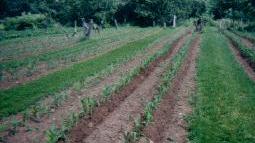
The corn seed was planted May 23 (average planting date for the region) and seedlings emerged 8 days later. Germination was very good. The weather remained unseasonably cold with frequent heavy rains. This may have lead to leaching of plant nutrients (especially nitrogen) from the top layer of soil to lower levels below the reach of the new plants. As a result, seedlings grew slowly after emergence and showed some yellowing of leaves. Growth was slower than normal for this stage.
"Corn grown at less than optimum fertility, soil aeration levels, pH, or light levels is more stressed than corn grown at optimum levels of these factors. These stresses can result in higher disease development by the corn being predisposed to infection and less hearty than when grown under less stress." Ref: (1a) p. 690
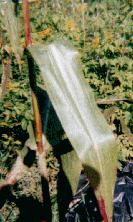

Cold and very moist conditions continued with only 15% of corn knee high by July 4 (average date for knee high in this area). This delay in growth may have resulted from stress and the fact that the total degree days (measure of average temperature) was behind the average for this area. Rust appeared early, with 20% of plants showing definite signs of an active rust infection by July 4, well before tasseling. Under normal conditions, corn rust forms late in the season (if at all) and usually has little, if any, effect on yield.
"Rust develops fastest under cool and wet conditions." Ref: (2)
"Infection occurs whenever moisture is present on leaves or in whorls for at least 2 hours." Ref: (2)
"Germination of urediospores [..of rust] occurs within 1 to 6 hrs, with infection structures forming in 3 to 4 hours. In 24 to 48 hours light green to yellow flecks may be visible on foliage." Ref: (3)
"As disease severity increases, pustules become more numerous and result in yellowing and death of leaves." Ref: (3)
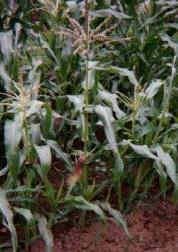
By the time tassels were appearing, it was obvious a serious rust infection was underway and spreading rapidly. Wet conditions continued to favor the spread of rust on plants that were already smaller than normal for this stage of growth.
"The earlier the infection becomes established the more severe the disease is likely to become." Ref: (1c p.711)
"..Corn plants are more susceptible to rust as 2 to 7 leaved seedings than after tassels emerge." Ref: (2) (2)

Most of the plants were showing serious rust infection. In addition, on August 2, 10 to 15% of corn plants were lodging (falling over). On close inspection plants that had fallen over showed signs of stem and root rot. The crop was behind normal in growth, with serious rust and lodging problems. Ear fill stage is a critical time for corn and the condition of the crop at this stage can have a major impact on yield.
".. even under marginal [.. rust] infection levels there is an effect on the infected plants. Grain filling may be nearly normal but the ears will develop at the expense of the stalk. This results in the plants affected by the foliar disease becoming more susceptible to common stalk rotting pathogens." Ref: (1a p. 696)
"In general, whenever growing conditions are favorable early in the growing season, corn plants will develop a large number of kernels. After flowering, the kernels will be a sink for carbohydrates within the plant. Whenever the plant does not produce enough carbohydrates for maintenance of all tissues, the grain sink has priority over other tissues. With intraplant competition for carbohydrates, tissues in the root and lower stem have low priority and cells in those tissues will senesce. As cells start to senesce those tissues become more susceptible to colonization by stalk rot organisms." Ref: (1d p. 727)

August 8, some corn plants were found with apparently no rust. Leaves were bright green. On very close inspection, leaves of these plants had very small yellow or white specs. These areas on the leaves looked like tiny rust infection sites (when compared to other infected plants) but the sites on these leaves did not spread or form pustules (or formed very few tiny pustules) and leaves appeared green and healthy. These plants were marked with orange tape so they could be observed through the rest of the season for evidence of rust.
"Varieties that are single gene resistant typically do not develop rust pustules [red infection sites] on leaves." Ref: (4)
"There are two different types of genetic resistance [.. to corn rust] currently available in commercial hybrids. The first of these is referred to as 'single gene resistance'. The plants show good resistance, however it is not considered a stable type of resistance because the disease continues to mutate with every new generation. This has resulted in a loss of single gene resistance in Mexico and Hawaii where multiple generations of the disease occur each year. A widespread use of varieties having single gene resistance would put great selective pressure on the disease to covercome the resistance. Since our inoculation source for the disease [.. in North America] is in the southern U.S. and Mexico, single gene resistant varieties would also be short-lived here.. [in northern US] " Ref: (4)
"A more stable type of resistance called 'polygenic resistance' [.. or durable resistance] is the most recent product of breeding programs. This resistance is more stable because several genes (as opposed to one) contribute to the resistance. It is much more difficult for the disease to overcome. Even though the polygenic resistant varieties have resistance, some rust pustules do form on the leaves. The level of infection, however, is usually low, does not spread, and generally has no impact on quality or yield. This type of resistance is often referred to as a hypersensitive reactions. Varieties that are single gene resistant typically do not develop rust pustules on leaves." Ref: (4)
"General resistance to P. sorghi [corn rust] results in a reduction of pustule number and size and in leaf necrosis (Kim, 1974). This resistance is observed best on older plants and is often referred to as "mature" or "adult plant" resistance." Ref: (1e p. 712)
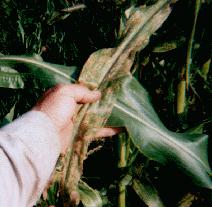
August 16, more plants were marked that were showing little if any rust on the leaves. Close inspection of leaves showed slightly more evidence of small scattered rust pustules than were found on the plants marked earlier with orange tape. These new plants were marked with blue tape. Their leaves produced very few active spore sites (pustules). These plants look only very slightly more infected than the orange marked plants. From a distance both blue and orange marked plants looked green and healthy.
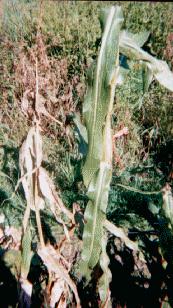
September 12, 1st pick of dry corn ears was 2 weeks later than normal. A significant number of plants appear to have lost all leaf to the rust and produced small ears or none at all (see photo left).
September 19, 2nd pick corn included ears that had dried to pick stage since the 1st pick a week earlier. Drying conditions were generally good.
Sept 26 3rd pick corn. Corn in this picking was late for this area. Only ears that were nearly dry were included in this harvest. All ears that were not dry enough to save for seed were picked and dried separately for use as corn meal because they were too late to save for seed for this season.
Crop Yield (includes all three pickings): About 40% of corn had no usable ears. Total yield was about 30% of normal (ie. about 70% loss of yield). This was due to failure of some plants to produce any ears and many plants producing ears about 1/2 to 1/3 of normal size.
"If enough tissue [.. in the leaf] is destroyed in the grain crop, the leaves will not be able to produce sufficient photosynthate to satisfy the plants needs. With plants exposed to high levels of foliar infection, the grain- filling process can be impaired to the point that direct losses will result." Ref: (1d p. 696)
"Yields are typically reduced by about 5% for each 10% of leaf area infected by rust." Ref: (2)
The crop had a bad start with cold and wet weather at planting time. Growth was slow because the temperature was low, and excessive rain may have leached nutrients (especially nitrogen) from the upper soil level making it less available to plant growth. The stressed plants were more vunerable to disease. With ideal conditions for rust formation (cold and wet), infection started early and lead to extensive leaf loss, slow growth and reduction in number and size of ears. The stressed plants suffered further with stem and root rot that resulted in many plants falling over (lodging) and reduced the yield by restricting nutrient uptake through the stem and root. The loss of yield due to stem and root rot could have been a very significant part of the total reduction of yield that added to the reduction caused by leaf lost to rust. The result was some of the worst conditions for slow growth and disease that we have seen in 20 years of growing this corn.
On the positive side, the growing season provided ideal conditions for selecting for disease resistance (in this case for corn rust) and for general ability to survive severe climatic conditions (cold, wet). Of the approximately 1,000 corn plants in the crop, 41 ears were harvested that showed resistance to rust. Two levels of resistance to rust were found. The corn harvest was divided into 4 categories:
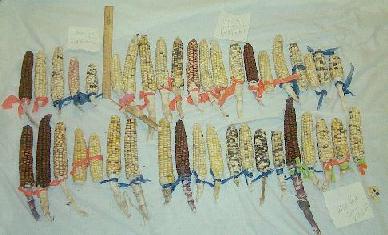
1) Rust resistant: level 1: very little evidence of rust infection on leaves with almost no viable pustules. Plants marked with orange tape.
2) Rust resistant: level 2: very little evidence of rust infection on leaves with only a few viable pustules. Plants marked with blue tape.
3) Season Survivors: Any plant that matured an ear was considered a Season Survivor. Plants that produced at least one ear was considered somewhat tolerant to the Rust/Climate conditions of this season. These plant may have had no tolerance to rust at all, but were able to survive and reproduce under extremely difficult conditions that included rust. (in contrast to 40% of the crop that produced no harvestable ears at all). This collection of plants contained genes that gave some advantage to the plants in ways that may or may not have had any direct connection to corn rust. For example, they may have had a higher tolerance to the cold and wet conditions of the season.
4) Season Non-Survivors: about 40% of the plants produced no harvestable ears at all. Although these plants produced no ears they did contribute to the gene pool of the 3 catagories above, by contributing pollen to the seeds that did form in the final crop.